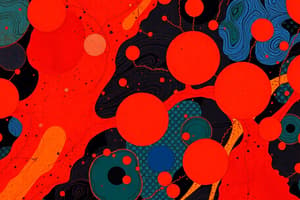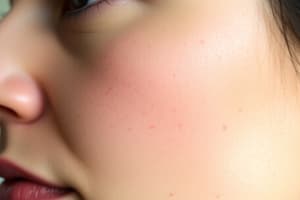Podcast
Questions and Answers
What color is typically associated with epidermal melasma?
What color is typically associated with epidermal melasma?
- Black
- Light brown to blue-grey
- Dark brown (correct)
- Yellowish
What key feature is noted in the dermoscopy of dermal melasma?
What key feature is noted in the dermoscopy of dermal melasma?
- Reticuloglobular pattern (correct)
- Blue-grey patches
- Dark fine granules
- Scattered islands of brown reticular network
Which type of melasma is defined by a combination of different colors?
Which type of melasma is defined by a combination of different colors?
- Epidermal melasma
- Dermal melasma
- Mixed melasma (correct)
- Sequential melasma
What is a crucial general measure for preventing melasma?
What is a crucial general measure for preventing melasma?
Which histological feature is NOT typically seen in melasma?
Which histological feature is NOT typically seen in melasma?
What is the most effective treatment combination reported for melasma?
What is the most effective treatment combination reported for melasma?
What type of hyperpigmentation can clinically resemble melasma?
What type of hyperpigmentation can clinically resemble melasma?
How is melasma typically diagnosed?
How is melasma typically diagnosed?
What is the primary feature of melasma?
What is the primary feature of melasma?
Which demographic is most affected by melasma?
Which demographic is most affected by melasma?
What environmental factor significantly contributes to the development of melasma?
What environmental factor significantly contributes to the development of melasma?
Which hormones are particularly associated with melasma in women?
Which hormones are particularly associated with melasma in women?
What pattern does melasma most commonly present in?
What pattern does melasma most commonly present in?
How is melasma classified based on the level of increased melanin in the skin?
How is melasma classified based on the level of increased melanin in the skin?
What is a potential treatment trigger for melasma?
What is a potential treatment trigger for melasma?
What percentage of individuals with melasma report a family history of the condition?
What percentage of individuals with melasma report a family history of the condition?
What is a characteristic feature of dermal melasma as compared to epidermal melasma?
What is a characteristic feature of dermal melasma as compared to epidermal melasma?
What is one of the major histological features typically seen in melasma?
What is one of the major histological features typically seen in melasma?
Which statement accurately describes the treatment response of mixed melasma?
Which statement accurately describes the treatment response of mixed melasma?
What monitoring tool is used to evaluate the treatment response for melasma?
What monitoring tool is used to evaluate the treatment response for melasma?
Which of the following would least likely lead to an accurate diagnosis of melasma?
Which of the following would least likely lead to an accurate diagnosis of melasma?
Which factor does NOT typically contribute to the visibility and diagnosis of melasma?
Which factor does NOT typically contribute to the visibility and diagnosis of melasma?
What is the defining feature of the reticuloglobular pattern seen in dermal melasma under dermoscopy?
What is the defining feature of the reticuloglobular pattern seen in dermal melasma under dermoscopy?
What general measure is essential for managing melasma effectively?
What general measure is essential for managing melasma effectively?
What is the main type of skin associated with the occurrence of melasma?
What is the main type of skin associated with the occurrence of melasma?
Which factor contributes least to the development of melasma in genetically predisposed individuals?
Which factor contributes least to the development of melasma in genetically predisposed individuals?
Which presentation pattern of melasma is most commonly observed?
Which presentation pattern of melasma is most commonly observed?
What is the primary cause attributed to the overproduction of melanin in melasma?
What is the primary cause attributed to the overproduction of melanin in melasma?
In what percentage of affected women is melasma associated with hormonal changes?
In what percentage of affected women is melasma associated with hormonal changes?
Which of the following types of melasma presents as reddish or inflamed patches?
Which of the following types of melasma presents as reddish or inflamed patches?
Which medication or product category is most likely to trigger melasma?
Which medication or product category is most likely to trigger melasma?
Which of the following is NOT a typical histological feature of melasma?
Which of the following is NOT a typical histological feature of melasma?
Flashcards
What is Melasma?
What is Melasma?
A common skin disorder characterized by bilateral, blotchy, brownish facial pigmentation.
Who gets Melasma?
Who gets Melasma?
Melasma is more prevalent in women, typically appearing between the ages of 20 and 40.
What causes Melasma?
What causes Melasma?
Melasma is caused by an overproduction of melanin, the pigment that gives skin its color.
What factors influence the appearance of Melasma?
What factors influence the appearance of Melasma?
Signup and view all the flashcards
What are the triggering factors for Melasma?
What are the triggering factors for Melasma?
Signup and view all the flashcards
What are the clinical features of Melasma?
What are the clinical features of Melasma?
Signup and view all the flashcards
How is Melasma classified?
How is Melasma classified?
Signup and view all the flashcards
What are the different patterns of Melasma?
What are the different patterns of Melasma?
Signup and view all the flashcards
Epidermal melasma
Epidermal melasma
Signup and view all the flashcards
Dermal melasma
Dermal melasma
Signup and view all the flashcards
Mixed melasma
Mixed melasma
Signup and view all the flashcards
How is melasma diagnosed?
How is melasma diagnosed?
Signup and view all the flashcards
What are the histological features of melasma?
What are the histological features of melasma?
Signup and view all the flashcards
What are the complications of melasma?
What are the complications of melasma?
Signup and view all the flashcards
What is the treatment for melasma?
What is the treatment for melasma?
Signup and view all the flashcards
What is the most successful topical therapy for melasma?
What is the most successful topical therapy for melasma?
Signup and view all the flashcards
Who is most likely to get Melasma?
Who is most likely to get Melasma?
Signup and view all the flashcards
What are the different types of Melasma?
What are the different types of Melasma?
Signup and view all the flashcards
How does Melasma present itself?
How does Melasma present itself?
Signup and view all the flashcards
What are some factors that trigger Melasma?
What are some factors that trigger Melasma?
Signup and view all the flashcards
What are the treatment options for Melasma?
What are the treatment options for Melasma?
Signup and view all the flashcards
What is epidermal melasma?
What is epidermal melasma?
Signup and view all the flashcards
What is dermal melasma?
What is dermal melasma?
Signup and view all the flashcards
What is mixed melasma?
What is mixed melasma?
Signup and view all the flashcards
Explain the general approach to melasma treatment.
Explain the general approach to melasma treatment.
Signup and view all the flashcards
Study Notes
Melasma Overview
- Melasma is a common acquired skin disorder
- It presents as bilateral, blotchy, brownish facial pigmentation
- Previously called chloasma, but the term melasma is now preferred
- It's derived from the Greek word meaning "to become green"
- Melasma commonly affects women aged 20-40
- More common in individuals with naturally brown skin or those who tan easily
- Less common in those with fair or black skin
Causes of Melasma
- Complex condition, potentially a photoaging disorder in genetically predisposed individuals
- Overproduction of melanin by melanocytes (pigment cells)
- Melanin either absorbed by keratinocytes (epidermal melanosis) or deposited in the dermis (dermal melanosis/melanophages)
- Factors implicated in development:
- Family history (60% report affected family members)
- Sun exposure (UV & visible light promotes melanin production)
- Hormones (pregnancy, contraceptives, hormone therapy)
- Medications and scented products (potential phototoxic reactions)
Clinical Features
- Melasma appears bilaterally, asymptomatic, light-to-dark brown macules or patches with irregular borders
- Distinct patterns: centrofacial (forehead, cheeks, nose, upper lip), malar (cheeks, nose), mandibular (jawline, chin)
- Erythosis pigmentosa faciei (reddened or inflamed)
- Extrafacial (forearms, upper arms, shoulders in sun-exposed distribution)
Types of Melasma
- Epidermal melasma: well-defined borders, dark brown colour, obvious under a Wood lamp, scattered brown islands and fine granules on dermoscopy. Good response to treatment.
- Dermal melasma: ill-defined borders, light brown to blue-grey colour, unclear under a Wood lamp, reticuloglobular dermoscopy.
- Mixed melasma: most common type, combination of blue-grey, light and dark brown colours. Mixed patterns seen with Wood lamp and dermoscopy. Treatment typically shows partial improvement
Diagnosis
- Usually clinical diagnosis based on the clinical appearance and examination with a wood lamp and dermatoscope
- Occasionally skin biopsy may be taken; histology varies with type, but common features include melanin deposition in basal and suprabasal keratinocytes, highly dendritic (branched) melanocytes, and melanin in dermal melanophages
- Sometimes solar elastosis (damage to the skin's elastic fibers) and increase in blood vessels are observed.
Differential Diagnosis
- Post-inflammatory hyperpigmentation
- Solar lentigo/lentigines and freckles
- Acquired dermal macular hyperpigmentation
- Drug-induced hyperpigmentation
- Naevus of Ota & naevus of Hor
Treatment
- Combination of general and topical measures generally required
- General measures:
- Year-round, lifelong sun protection (broad-brimmed hat, high SPF sunscreen with iron oxides, sunsmart behaviour)
- Discontinuing hormonal contraception (if possible)
- Cosmetic camouflage
- Topical therapy:
- Combination of hydroquinone, tretinoin, and moderate topical steroids (skin lightening creams) is highly effective (reported to clear or improve 60-80%)
- Additional topical agents: azelaic acid, kojic acid, cysteamine cream, ascorbic acid, methimazole, tranexamic acid, glutathione, and soybean extract. Many other agents are under investigation.
- Oral treatment:
- Tranexamic acid blocks the conversion of plasminogen to plasmin, and is known to inhibit prostaglandin synthesis. More oral treatments are being trialled
- Procedural Techniques:
- Chemical peels and laser treatments can be used with caution but may worsen melasma or cause post-inflammatory hyperpigmentation
- Patients should be pretreated with a tyrosinase inhibitor (like hydroquinone)
- Superficial treatments: alpha-hydroxy acids (AHAs) and beta-hydroxy acids (BHAs) such as glycolic acid and salicylic acid are possible.
Monitoring
- Serial photography and severity indices (like the Melasma Area & Severity Index (MASI)) can be used to monitor response to treatment.
Studying That Suits You
Use AI to generate personalized quizzes and flashcards to suit your learning preferences.




